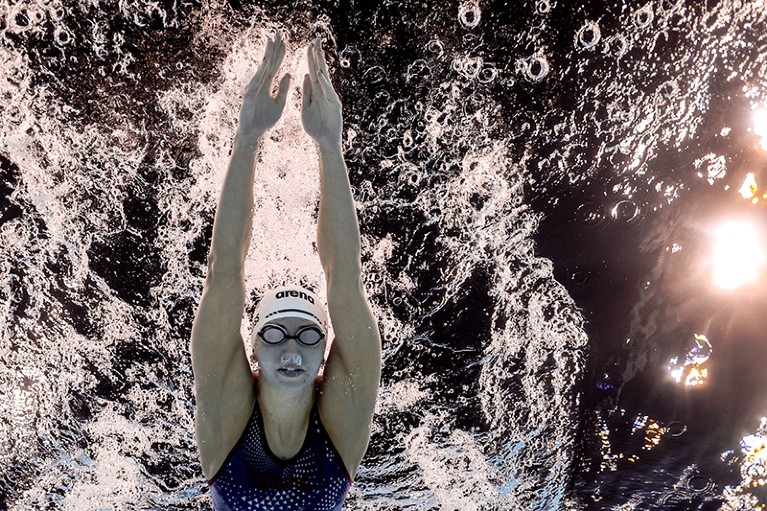Kate Douglass of Team USA is one of the athletes Ken Ono has worked with.Credit: Reuters/Marko Djurica
The medals keep coming for US swimmers at the 2024 Olympic Games in Paris — and that’s in part thanks to science.
Several of the athletes on Team USA have improved their times dramatically in recent years, and some of these improvements could be down to Ken Ono, a mathematician at the University of Virginia in Charlottesville. Working for years with students who are on the university’s swimming team, Ono has developed techniques to monitor the fine movements of the body in the pool. He and his collaborator Jerry Lu, who is at the Sports Lab at the Massachusetts Institute of Technology in Cambridge, then create 3D models of the athletes and suggest tiny changes that can shave off precious fractions of a second at every stroke.
Ono, whose day job is studying problems in number theory, spoke with Nature from Paris, where he is supporting the swimming team.
How do you help swimmers to improve their performance?
We help them swim a little bit more efficiently with precision training — using wearable technology to optimize an individual for the events that they choose. We identify targets of opportunity that can improve their performance, and that have been deduced scientifically.
Do you have an official role in Team USA?
For these Olympics, Jerry Lu and I are consultants on the outside — officially, we’re ‘friends and family’, not coaching staff: the number of coaches the Olympic committee regulations allow is quite limited. We’re not getting rich off this — I don’t want to be paid. It’s an opportunity to explain and highlight in very crystal-clear terms the role that science plays in everything that is human and everything we can observe. But there certainly are perks: we’re invited to US Olympic team events! What we do is a very small part, but it is thrilling to see the medals come to fruition.
How did you get started in this work?
When we first started out, this was basically just a semester-long experiment working with college swimmers. But as some of those athletes emerged at national- and international-level talent, very-high-level coaches began to notice — including US national team coaching staff.
We live at a particular point in time when we need to think about where we will be in ten years, rather than making small, incremental changes. So many of the sports have already experienced this transition. This just happens to be swimming’s moment. There are significant engineering obstacles one has in swimming. When an athlete swims in a pool, the water gets in the way. Electronic devices have to be fine-tuned to work in the water.
Has working with athletes changed your job as an academic?
Yes, but in an unexpected way. Does this work help me prove theorems about distribution of prime numbers? No. But if I’ve learnt one thing, even from the last few days, it is that there is a thirst for new applications of mathematics and science beyond what people traditionally think of as mathematics. So it gives me and my community of mathematicians around the world a new platform. As much as we want to talk about the Langlands programme, or the Riemann hypothesis, in a way, we’re all studying probability distributions or mathematical phenomena, but just in different settings. I like that.
Is it possible that, owing to technology and science, people might swim in a completely different way 10 years from now than they do today?
The definition of athletic events has to evolve with the sport. Still, I’m fairly confident that, 10 or 20 years from now, breaststroke, butterfly, freestyle and backstroke will look to the casual observer what they look like today. But the times will continue to get faster.
